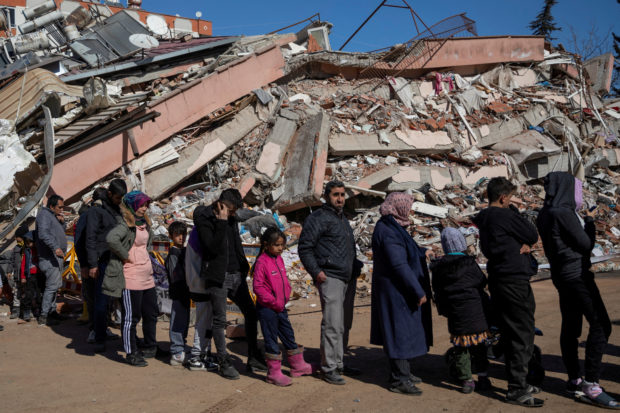
People queue for free food served amid the rubble following the deadly earthquake in Kahramanmaras, Turkey, February 16, 2023. REUTERS/Eloisa Lopez
KAHRAMANMARAS/ANTAKYA, Turkey — International aid agencies are stepping up efforts to help millions of homeless people, many sleeping in tents, mosques, schools, or cars, 11 days after a massive earthquake hit Turkey and Syria killing more than 42,000.
Two people were reported to have been pulled alive from the rubble in Turkey on Thursday, February 16, but such rescues have become increasingly rare, leaving anger to smolder as hope dies.
A 17-year-old girl was extracted from the ruins of a collapsed apartment bloc in Turkey’s southeastern Kahramanmaras province, broadcaster TRT Haber reported, 248 hours since the 7.8 magnitude earthquake struck in the dead of night on February 6.
Footage showed her being carried away on a stretcher covered with a thermal blanket while an emergency worker held an intravenous drip.
About 10 hours later, Neslihan Kilic was rescued.
“We had prepared her grave and we asked the rescue workers to stop digging as we feared they would damage the remaining corpses under the rubble. Moments later, her voice was heard from under the ruins of the building,” Kilic’s brother-in-law told broadcaster CNN Turk.
Kilic’s husband and two children are still missing.
READ: LIVE UPDATES: Earthquake in Turkey and Syria
The quake killed at least 36,187 people in southern Turkey while authorities in neighboring Syria have reported 5,800 deaths – a figure that has changed little in days.
The United Nations on Thursday appealed for more than $1 billion in funds for the Turkish relief operation, just two days after launching a $400 million appeal for Syrians.
Syrian President Bashar al-Assad, speaking on Thursday in his first televised comments since the quake hit, said the response to the disaster required more resources than the government had available.
Neither Turkey nor Syria have said how many people are still missing.
READ: Race to identify Turkey quake victims
U.N. aid chief Martin Griffiths, who visited Turkey last week, said the people had “experienced unspeakable heartache”, adding: “We must stand with them in their darkest hour and ensure they receive the support they need.”
For families still waiting to retrieve relatives, there is growing anger over what they see as corrupt building practices and deeply flawed urban development that resulted in thousands of homes and businesses disintegrating.
“I have two children. No others. They are both under this rubble,” said Sevil Karaabdüloğlu, as excavators tore down what remained of a high-end block of flats in the southern Turkish city of Antakya, where her two daughters had lived.
READ: Filipino, 3 kids still missing in Turkey after quake
About 650 people are believed to have died when the Renaissance Residence collapsed.
“We rented this place as an elite place, a safe place. How do I know that the contractor built it this way? … Everyone is looking to make a profit. They’re all guilty,” she said.
Some 200 km (125 miles) away, about 100 people gathered at a small cemetery in the town of Pazarcik to bury a family of four – Ismail and Selin Yavuzatmaca and their two young daughters – who all died in the Renaissance building.
Turkey has promised to investigate anyone suspected of responsibility for the collapse of buildings and has ordered the detention of more than 100 suspects, including developers.
People take their belongings from their apartments in the aftermath of a deadly earthquake in Antakya, Turkey February 16, 2023. REUTERS/Maxim Shemetov
Border crossings
Across the border in Syria, the earthquake slammed a region divided and devastated by 12 years of civil war.
The Syrian government says the death toll in territory it controls is 1,414. More than 4,000 fatalities have been reported in the rebel-held northwest, but rescuers say nobody has been found alive there since February 9.
READ: Death toll rises above 41,000 in Turkey, Syria quake
The aid effort has been hampered by the conflict and many people in the northwest feel abandoned as supplies almost invariably head to other parts of the sprawling disaster zone.
Deliveries from Turkey were severed completely in the immediate aftermath of the earthquake, when a route used by the United Nations was temporarily blocked. This week, Assad granted approval for two additional crossings.
As of Thursday, 119 U.N. trucks had gone through the Bab al-Hawa and Bab al-Salam crossings since the earthquake, a spokesperson for the U.N. Office for the Coordination of Humanitarian Affairs told Reuters.
READ: Miracle rescues a week after Turkey-Syria quake
Many survivors have fled the disaster zones, but some have decided to stay, despite the dreadful conditions.
“We spend our days with bread, soup and meals as part of the aid sent by people. We don’t have a life any more. We are afraid,” said Mustafa Akan in Adiyaman, who sleeps outdoors and stays warm by burning wood in a bucket.